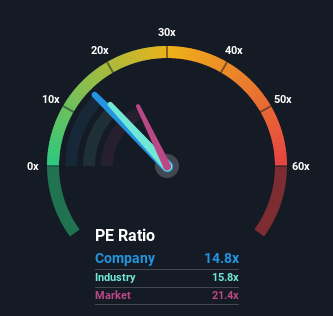Little Excitement Around Manomay Tex India Limited's (NSE:MANOMAY) Earnings As Shares Take 25% Pounding

Manomay Tex India Limited (NSE:MANOMAY) shares have had a horrible month, losing 25% after a relatively good period beforehand. To make matters worse, the recent drop has wiped out a year's worth of gains with the share price now back where it started a year ago.
Following the heavy fall in price, Manomay Tex India's price-to-earnings (or "P/E") ratio of 14.8x might make it look like a buy right now compared to the market in India, where around half of the companies have P/E ratios above 22x and even P/E's above 43x are quite common. However, the P/E might be low for a reason and it requires further investigation to determine if it's justified.
Manomay Tex India certainly has been doing a great job lately as it's been growing earnings at a really rapid pace. One possibility is that the P/E is low because investors think this strong earnings growth might actually underperform the broader market in the near future. If that doesn't eventuate, then existing shareholders have reason to be quite optimistic about the future direction of the share price.
See our latest analysis for Manomay Tex India

What Are Growth Metrics Telling Us About The Low P/E?
Manomay Tex India's P/E ratio would be typical for a company that's only expected to deliver limited growth, and importantly, perform worse than the market.
If we review the last year of earnings growth, the company posted a terrific increase of 43%. The strong recent performance means it was also able to grow EPS by 70% in total over the last three years. Therefore, it's fair to say the earnings growth recently has been superb for the company.
Comparing that to the market, which is predicted to deliver 25% growth in the next 12 months, the company's momentum is weaker based on recent medium-term annualised earnings results.
With this information, we can see why Manomay Tex India is trading at a P/E lower than the market. It seems most investors are expecting to see the recent limited growth rates continue into the future and are only willing to pay a reduced amount for the stock.
The Key Takeaway
Manomay Tex India's P/E has taken a tumble along with its share price. Typically, we'd caution against reading too much into price-to-earnings ratios when settling on investment decisions, though it can reveal plenty about what other market participants think about the company.
We've established that Manomay Tex India maintains its low P/E on the weakness of its recent three-year growth being lower than the wider market forecast, as expected. At this stage investors feel the potential for an improvement in earnings isn't great enough to justify a higher P/E ratio. If recent medium-term earnings trends continue, it's hard to see the share price rising strongly in the near future under these circumstances.
There are also other vital risk factors to consider and we've discovered 3 warning signs for Manomay Tex India (2 are potentially serious!) that you should be aware of before investing here.
Of course, you might also be able to find a better stock than Manomay Tex India. So you may wish to see this free collection of other companies that sit on P/E's below 20x and have grown earnings strongly.
New: Manage All Your Stock Portfolios in One Place
We've created the ultimate portfolio companion for stock investors, and it's free.
• Connect an unlimited number of Portfolios and see your total in one currency
• Be alerted to new Warning Signs or Risks via email or mobile
• Track the Fair Value of your stocks
Have feedback on this article? Concerned about the content? Get in touch with us directly. Alternatively, email editorial-team (at) simplywallst.com.
This article by Simply Wall St is general in nature. We provide commentary based on historical data and analyst forecasts only using an unbiased methodology and our articles are not intended to be financial advice. It does not constitute a recommendation to buy or sell any stock, and does not take account of your objectives, or your financial situation. We aim to bring you long-term focused analysis driven by fundamental data. Note that our analysis may not factor in the latest price-sensitive company announcements or qualitative material. Simply Wall St has no position in any stocks mentioned.
About NSEI:MANOMAY
Manomay Tex India
Manufactures and sells denims and denim fabrics in India.
Solid track record and slightly overvalued.
Similar Companies
Market Insights
Community Narratives



